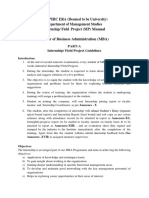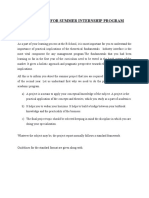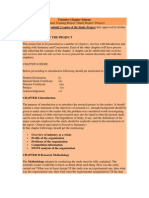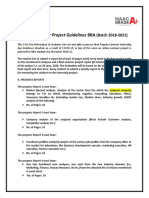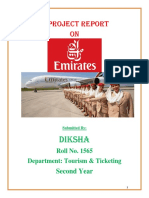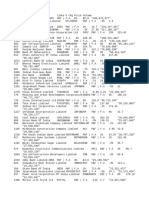0 ratings0% found this document useful (0 votes)
58 viewsStudy Report Guidelines
Study Report Guidelines
Uploaded by
Amit ChoudharyThe document provides guidelines for writing a study report, including its structure and components. It states that the report should be 30-40 pages long, typed in Times New Roman 12pt font with 1.5 line spacing. It should not copy directly from sources without citations, and any verbatim text or narratives must be in quotes with full references. The report should include chapters on an introduction, literature review, relevance of the study, problem identification, methodology, data analysis and interpretation, recommendations and conclusion. The methodology chapter should describe the research design, population, sampling, instruments, data collection and analysis.
Copyright:
© All Rights Reserved
Available Formats
Download as DOC, PDF, TXT or read online from Scribd
Study Report Guidelines
Study Report Guidelines
Uploaded by
Amit Choudhary0 ratings0% found this document useful (0 votes)
58 views2 pagesThe document provides guidelines for writing a study report, including its structure and components. It states that the report should be 30-40 pages long, typed in Times New Roman 12pt font with 1.5 line spacing. It should not copy directly from sources without citations, and any verbatim text or narratives must be in quotes with full references. The report should include chapters on an introduction, literature review, relevance of the study, problem identification, methodology, data analysis and interpretation, recommendations and conclusion. The methodology chapter should describe the research design, population, sampling, instruments, data collection and analysis.
Original Description:
College Guideline
Original Title
FIIB Guideline
Copyright
© © All Rights Reserved
Available Formats
DOC, PDF, TXT or read online from Scribd
Share this document
Did you find this document useful?
Is this content inappropriate?
The document provides guidelines for writing a study report, including its structure and components. It states that the report should be 30-40 pages long, typed in Times New Roman 12pt font with 1.5 line spacing. It should not copy directly from sources without citations, and any verbatim text or narratives must be in quotes with full references. The report should include chapters on an introduction, literature review, relevance of the study, problem identification, methodology, data analysis and interpretation, recommendations and conclusion. The methodology chapter should describe the research design, population, sampling, instruments, data collection and analysis.
Copyright:
© All Rights Reserved
Available Formats
Download as DOC, PDF, TXT or read online from Scribd
Download as doc, pdf, or txt
0 ratings0% found this document useful (0 votes)
58 views2 pagesStudy Report Guidelines
Study Report Guidelines
Uploaded by
Amit ChoudharyThe document provides guidelines for writing a study report, including its structure and components. It states that the report should be 30-40 pages long, typed in Times New Roman 12pt font with 1.5 line spacing. It should not copy directly from sources without citations, and any verbatim text or narratives must be in quotes with full references. The report should include chapters on an introduction, literature review, relevance of the study, problem identification, methodology, data analysis and interpretation, recommendations and conclusion. The methodology chapter should describe the research design, population, sampling, instruments, data collection and analysis.
Copyright:
© All Rights Reserved
Available Formats
Download as DOC, PDF, TXT or read online from Scribd
Download as doc, pdf, or txt
You are on page 1of 2
8.
Study Report Guidelines
The Formal report is the outcome of detailed investigation of the problem undertaken by the student.
Students are supposed to prepare a written report. The report should be written in students own
words.
1. Students are required to submit one spiral bound copy of the report.
2. All the students are required to follow the instructions summarized below for report writing:
a. The cover page of the Study Report should be in accordance to the format prescribed
b. The size of the report would be between 30-40 pages. The typed pages of the report should be
on A4 size paper with 1.5 line spacing. All the students are required to use the Times New Roman
of font size 12 (except in heading and subheadings) throughout the text of the report.
c. Not a single sentence should be copied from the original source, unless it is being quoted with
due acknowledgement. Giving a list of references does not entitle student to copy sentences from the
sources. All exhibits/tables/diagrams etc., taken directly from other sources must be acknowledged.
d. In case of any verbatim or narratives, enclose them in quotes with full references.
4. Report Structure
In general final project report should comprise of the following components:-
Cover page
Certificate from Faculty Guide along with declaration of student.
Acknowledgement
Table of Contents
List of Tables
List of Figures & Graphs
Following chapters should be included after the above components:
Chapter I Introduction to Topic and Organizations
Chapter II Literature review: This section of the research report would mean writing the relevant
theory, concept and research findings from the already published and available sources related to
research topic.
Chapter III Relevancy of the Study: This chapter will deal with the explanation of what will be the
new contribution by your study. In a sense it explains the gap you have observed and understand
while conducting literature review.
Chapter IV Problem Identification and Study Objectives
Chapter V Methodology: This chapter will be about the description of your research architecture. It
will talk about steps of your research process, research design, data collection methods, sampling
design, data analysis plan, formulation of hypothesis related to your research topic etc.
Keeping the problem statement in mind, take into account the following aspects
Research Design
Research Population;
Sample;
Sampling methodology; Sample size;
Research Instruments
Data Collection (state sources of information and sampling methods, strengths
and weaknesses of these methods);
Data Analysis (explain how the information collected will be organised and
analysed);
Chapter VI Data analysis and interpretation
Chapter VII Recommendation and Conclusion
Bibliography
The following framework is to be referred while undergoing the Project:- (Chapter I)
Industry Overview
I. Define the Industry (what does it include etc.), also list the various segments
II. Define the geographic scope
III. Followed by Porters Five Forces Analysis
Market Value Analysis and Segmentation
I. The market size in terms of value (last 5 years and if available a forecast)
Explain the growth, decline, peaks and troughs
II. Also, give the value by the segment and create a pie illustrating the contribution
Trend Analysis & Competitive Landscape
I. What are the growth drivers and challenges for the industry
II. What are the leading trends in the industry and how will they affect the market
development in the coming years (positive or negative)
III. Is the market consolidated or fragmented?? (Mention the leading players and their
market share, at the end a SWOT analysis)
Future Outlook
I. How is the industry expected to develop in the coming future
Both in terms of market size, changes in business models, change in
competitive landscape (M&A activities)
Company Analysis
Brief about the Company
I. Company Introduction Principal business activity, revenues (last two years),
number of employees, key management
II. Organizational Structure
Products and Services and Company Segments
I. Various product and customer segments and their contribution to the revenue
Business Strategy
I. Includes organizational strategies like new product development, geographic
expansion, restructuring, etc.
Issues and Challenges
I. Various macro level issues and challenges faced by the company and its response to
the same
You might also like
- Mba 4th Sem Project DissertationDocument16 pagesMba 4th Sem Project Dissertationsandhya33% (3)
- Business Plan Checklist: Plan your way to business successFrom EverandBusiness Plan Checklist: Plan your way to business successRating: 5 out of 5 stars5/5 (1)
- World Gas Map 2015Document1 pageWorld Gas Map 2015IBHWANGNo ratings yet
- Integrated Term Project ScopeDocument2 pagesIntegrated Term Project ScopeSachin JoshiNo ratings yet
- Merger & Acquisition D1UA511T Dr. Ruchi AtriDocument9 pagesMerger & Acquisition D1UA511T Dr. Ruchi AtriManan AswalNo ratings yet
- Course Code: GMDocument2 pagesCourse Code: GMShubhankar VaishNo ratings yet
- Summer Internship Project GuidelineDocument9 pagesSummer Internship Project GuidelineAnkit DixitNo ratings yet
- Institute of Information Technology & Management, New Delhi Academic Circular 4/2007Document17 pagesInstitute of Information Technology & Management, New Delhi Academic Circular 4/2007Harsh SaxenaNo ratings yet
- Project Work: Department of Commerce Session2015-1017Document5 pagesProject Work: Department of Commerce Session2015-1017Shyam ShankarNo ratings yet
- InstructionsDocument10 pagesInstructionsGaurav ChahalNo ratings yet
- Guidelines On InternshipDocument8 pagesGuidelines On InternshipSyed Irfan Bin InayatNo ratings yet
- Mgt489 Project Report GuidelineDocument6 pagesMgt489 Project Report GuidelineSyedSalmanRahmanNo ratings yet
- Guidelines MBA Internship Field Project MBA IIIDocument29 pagesGuidelines MBA Internship Field Project MBA IIISumit DevlalNo ratings yet
- Annexure VII (Project Guidlines)Document6 pagesAnnexure VII (Project Guidlines)vidyabhushanNo ratings yet
- Project Guidelines For BBA - SMUDocument9 pagesProject Guidelines For BBA - SMURahul DewanNo ratings yet
- Guidelines-Summer Projects 2020 IIMSDocument7 pagesGuidelines-Summer Projects 2020 IIMSShefali ShrivastavaNo ratings yet
- 4 SCM Project - Guidelines 2021Document2 pages4 SCM Project - Guidelines 2021Satish KumarNo ratings yet
- Inquiries Investigations and Immersions Module 2 ABMDocument4 pagesInquiries Investigations and Immersions Module 2 ABMhoneybabe.solitoNo ratings yet
- Vivekananda Institute of Professional Studies Vivekananda School of Business StudiesDocument10 pagesVivekananda Institute of Professional Studies Vivekananda School of Business StudiesRajiv RawatNo ratings yet
- Guidelines-Summer Projects 2015 MBADocument7 pagesGuidelines-Summer Projects 2015 MBAAKSHAYNo ratings yet
- 21 Project Report and Viva Voce - BBADocument10 pages21 Project Report and Viva Voce - BBAAbhishek PathakNo ratings yet
- 2-SM - Assign2-Strategic Audit Report (30 Points)Document10 pages2-SM - Assign2-Strategic Audit Report (30 Points)mohNo ratings yet
- BBA Project GuidelinesDocument22 pagesBBA Project Guidelinesking mafiaNo ratings yet
- Guidelines For Project Report - UpdatedDocument11 pagesGuidelines For Project Report - UpdatedRishabh GuptaNo ratings yet
- STPR 24(10R)Document3 pagesSTPR 24(10R)akashshukla8419No ratings yet
- Tentative Chapter SchemeDocument3 pagesTentative Chapter SchemeDigvijay SinghNo ratings yet
- Guidelines For Summer Project ReportDocument5 pagesGuidelines For Summer Project ReportSonia RaiNo ratings yet
- Guidelines On Process and Evaluation of Corporate Internship-2011-Suggestions IncorporatedDocument5 pagesGuidelines On Process and Evaluation of Corporate Internship-2011-Suggestions IncorporatedSaurabh BansalNo ratings yet
- Tentative Chapter Scheme: (Summer Training Project / Study Project / Project)Document9 pagesTentative Chapter Scheme: (Summer Training Project / Study Project / Project)Naveen GeneNo ratings yet
- Guidelines For Project Report and Viva Voce: Bachelor of Business Administration Bba Vi-SemesterDocument16 pagesGuidelines For Project Report and Viva Voce: Bachelor of Business Administration Bba Vi-SemesterRizzy PopNo ratings yet
- Guidelines On Process and Evaluation of Corporate Internship-2012Document5 pagesGuidelines On Process and Evaluation of Corporate Internship-2012Sandipan NagNo ratings yet
- Online Summer Project Guidelines BBA: (Batch 2018-2021)Document5 pagesOnline Summer Project Guidelines BBA: (Batch 2018-2021)Manraj kaurNo ratings yet
- Summer TRG Report FormatDocument3 pagesSummer TRG Report FormatsnehabhambhaniNo ratings yet
- Guidelines For Summer Project ReportDocument4 pagesGuidelines For Summer Project ReportAk HilNo ratings yet
- IIP Fianl Report GuidelinesDocument5 pagesIIP Fianl Report GuidelinesyatinasthaNo ratings yet
- Project Guideline For 5th SemDocument12 pagesProject Guideline For 5th SemJatinNo ratings yet
- Guidelines For Project Dissertation: Master of Business Administration Mba Iv-SemesterDocument16 pagesGuidelines For Project Dissertation: Master of Business Administration Mba Iv-Semestermohangoel99No ratings yet
- Assignment ListDocument9 pagesAssignment ListAmity Sec A NoidaNo ratings yet
- Guidelines Bba 310 PRVV Vi I Ii PDFDocument16 pagesGuidelines Bba 310 PRVV Vi I Ii PDFmohit sharmaNo ratings yet
- Report FormatDocument1 pageReport FormatMagda HamidNo ratings yet
- Bhagwan Parshuram Institute of Technology School of Business AdministrationDocument13 pagesBhagwan Parshuram Institute of Technology School of Business AdministrationKamal PanchalNo ratings yet
- Organizational Study GuidelinesDocument9 pagesOrganizational Study GuidelinesApoorv SinghNo ratings yet
- Dissertation For II Year M .Com StudentsDocument12 pagesDissertation For II Year M .Com Studentsnischal mathewNo ratings yet
- Format 1Document18 pagesFormat 1529 NeerajNo ratings yet
- Guidelines For MbaDocument21 pagesGuidelines For MbahmanshrmNo ratings yet
- Sample Feasibility Study FormatDocument4 pagesSample Feasibility Study FormatMae RxNo ratings yet
- Guidelines For The Group Project - ME 21Document3 pagesGuidelines For The Group Project - ME 21Encore GamingNo ratings yet
- Business Strategy Planning Assignments, Presentation & Project GuidelinesDocument3 pagesBusiness Strategy Planning Assignments, Presentation & Project GuidelinesAhmedNo ratings yet
- Sample Feasibility FormatDocument5 pagesSample Feasibility FormatAnonymous OneNo ratings yet
- Summer Intership Project Guidelines 2023 Withschedule BBADocument33 pagesSummer Intership Project Guidelines 2023 Withschedule BBAyogtiwari3366No ratings yet
- Summer Training ReportDocument14 pagesSummer Training ReportRonica MahajanNo ratings yet
- Intership DossierDocument16 pagesIntership DossierMishika WadhwaniNo ratings yet
- UIAMS Summer Internship Guidelines 2023-25Document5 pagesUIAMS Summer Internship Guidelines 2023-25gurtejtestingNo ratings yet
- Project Guidelines Final FormatDocument17 pagesProject Guidelines Final FormatskbsantoshNo ratings yet
- Bcom Major Project BriefingDocument22 pagesBcom Major Project BriefingBhavya LambaNo ratings yet
- Sip PPT Guidelines 2022Document19 pagesSip PPT Guidelines 2022Viplove MahatoNo ratings yet
- Guidelines For Summer Internship Project (Sip) AND Summer Internship Report (Sir)Document5 pagesGuidelines For Summer Internship Project (Sip) AND Summer Internship Report (Sir)Gourav GuptaNo ratings yet
- Organization of The Project: Chapter SchemeDocument4 pagesOrganization of The Project: Chapter Schemeraman_bhoomi2761No ratings yet
- Guidelines For Summer Project ReportDocument5 pagesGuidelines For Summer Project ReportCHIRAG ABROLNo ratings yet
- MBA Capstone Module GuideDocument25 pagesMBA Capstone Module GuideGennelyn Grace PenaredondoNo ratings yet
- WORK IN PROGRESS REPORT - I - Annex - 1Document1 pageWORK IN PROGRESS REPORT - I - Annex - 1Amit ChoudharyNo ratings yet
- MBA Dissertation Guidelines: Type of ProjectDocument4 pagesMBA Dissertation Guidelines: Type of ProjectAmit ChoudharyNo ratings yet
- Soft Drinks-OUTLINE FOR THESISDocument2 pagesSoft Drinks-OUTLINE FOR THESISAmit ChoudharyNo ratings yet
- WORK IN PROGRESS REPORT - I - Annex - 1Document1 pageWORK IN PROGRESS REPORT - I - Annex - 1Amit ChoudharyNo ratings yet
- Thesis Outline On Product Performance - docBMDocument2 pagesThesis Outline On Product Performance - docBMAmit ChoudharyNo ratings yet
- Topic Budget Hotels - Increase in Growth and Importance in Delhi-Ncr in The Last DecadeDocument20 pagesTopic Budget Hotels - Increase in Growth and Importance in Delhi-Ncr in The Last DecadeAmit ChoudharyNo ratings yet
- Questionnaire: 1. GenderDocument5 pagesQuestionnaire: 1. GenderAmit ChoudharyNo ratings yet
- Submitted in Partial Fulfilment of The Requirements FOR (MMS)Document15 pagesSubmitted in Partial Fulfilment of The Requirements FOR (MMS)Amit ChoudharyNo ratings yet
- For The Same The Student Is Required To Submit A Report To The InstituteDocument3 pagesFor The Same The Student Is Required To Submit A Report To The InstituteAmit ChoudharyNo ratings yet
- Thesis KolkataDocument2 pagesThesis KolkataAmit ChoudharyNo ratings yet
- Emirates (Airline)Document38 pagesEmirates (Airline)Amit Choudhary100% (1)
- Management of Financial Services - FM06Document16 pagesManagement of Financial Services - FM06Amit ChoudharyNo ratings yet
- Internet Boom For Tourism IndustryDocument4 pagesInternet Boom For Tourism IndustryAmit ChoudharyNo ratings yet
- 1 Draw 10 Member - Juicer Mixer GrinderDocument19 pages1 Draw 10 Member - Juicer Mixer GrinderAmit ChoudharyNo ratings yet
- A Project Report ON: NikitaDocument35 pagesA Project Report ON: NikitaAmit ChoudharyNo ratings yet
- To Whomsoever It May ConcernDocument1 pageTo Whomsoever It May ConcernAmit ChoudharyNo ratings yet
- Visual Merchandising Elements Exterior PresentationDocument9 pagesVisual Merchandising Elements Exterior PresentationAmit ChoudharyNo ratings yet
- Internet Boom For Tourism Industry SynopsisDocument10 pagesInternet Boom For Tourism Industry SynopsisAmit ChoudharyNo ratings yet
- Chapter One A Genealogy of The Domestic: The Nation: Private/Public?Document45 pagesChapter One A Genealogy of The Domestic: The Nation: Private/Public?Amit ChoudharyNo ratings yet
- Research Tools & Techniques 1Document4 pagesResearch Tools & Techniques 1Amit ChoudharyNo ratings yet
- Cadre Pos. NBR Position Title Poornata ID Positi On Hierar Chy Name Display As Par PoornataDocument40 pagesCadre Pos. NBR Position Title Poornata ID Positi On Hierar Chy Name Display As Par PoornataSiddhant SatpathyNo ratings yet
- URIKAR - The Most Advanced & Powerful Percussion Massager With AI Chip For Daily Stress Relief and Workout RecoveryDocument2 pagesURIKAR - The Most Advanced & Powerful Percussion Massager With AI Chip For Daily Stress Relief and Workout RecoveryPR.comNo ratings yet
- Sharp LC 50le458x TV Service ManualDocument41 pagesSharp LC 50le458x TV Service ManualNikhil Suresh100% (1)
- Stannous Oxalate CAS 814-94-8 Industry Market Research ReportDocument10 pagesStannous Oxalate CAS 814-94-8 Industry Market Research ReportAlkeshNo ratings yet
- Brosjyre Niton XL5Document2 pagesBrosjyre Niton XL5Agustin A.No ratings yet
- Ayush - Resume 2Document2 pagesAyush - Resume 2ayushpatnaik7No ratings yet
- ETQ-FM-006 Assessor-Moderator Registration Form (Due For Review by 28 Oct 2017)Document5 pagesETQ-FM-006 Assessor-Moderator Registration Form (Due For Review by 28 Oct 2017)Sibusiso Mhambi100% (2)
- 2 CE155 - MQT EarthworksDocument17 pages2 CE155 - MQT EarthworksAlbert SaludNo ratings yet
- Magnetostrictive TransducersDocument17 pagesMagnetostrictive TransducersPrathamesh BhutraNo ratings yet
- Oel Lab Report Front Page - Level 2Document13 pagesOel Lab Report Front Page - Level 2Noradila RoslanNo ratings yet
- Chapter 3: Research Methodology: The Aim Is ToDocument4 pagesChapter 3: Research Methodology: The Aim Is ToSIMON JOSIAHNo ratings yet
- Sap SD End User Manual Step by StepDocument47 pagesSap SD End User Manual Step by StepAhmed HanyNo ratings yet
- Overzicht 2019Document2 pagesOverzicht 2019mihai12moveNo ratings yet
- 2024 Biennial Conference Call For Research ProposalsDocument6 pages2024 Biennial Conference Call For Research ProposalsAidan SullivanNo ratings yet
- Cs 101Document29 pagesCs 101hamza abbasNo ratings yet
- Dashboard and ConsoleDocument4 pagesDashboard and Consolepavel35No ratings yet
- GENTEX TesterDocument2 pagesGENTEX Testercarlos ibarraNo ratings yet
- 4.2.3 Ballistic Device: Stony Point Hs - Round Rock Isd PLTWDocument10 pages4.2.3 Ballistic Device: Stony Point Hs - Round Rock Isd PLTWapi-318013538No ratings yet
- Cisco Cucm DB RepDocument10 pagesCisco Cucm DB Repritesh_tany783321No ratings yet
- Risk Management and Training Hazard AnalysisDocument32 pagesRisk Management and Training Hazard AnalysisHamdi RafiekNo ratings yet
- Stock Screener, Technical Analysis ScannerDocument3 pagesStock Screener, Technical Analysis ScannerVishal RaoNo ratings yet
- Ym276serviceengine3t84ha PDFDocument662 pagesYm276serviceengine3t84ha PDFSonnyc97100% (3)
- Walkie Counterbalanced, Straddle, Reach RCS20,30,40 RSS22,30,40 RRS30Document435 pagesWalkie Counterbalanced, Straddle, Reach RCS20,30,40 RSS22,30,40 RRS30Marcos JuradoNo ratings yet
- 10 1 1 554 2000Document7 pages10 1 1 554 2000Amir Ali JanbakhshNo ratings yet
- Vermeer D24x40Document2 pagesVermeer D24x40Jhon CanizalesNo ratings yet
- Non-Povo88 Create Umsl PsDocument27 pagesNon-Povo88 Create Umsl Psvijay1136No ratings yet
- Learned Society: From Wikipedia, The Free EncyclopediaDocument3 pagesLearned Society: From Wikipedia, The Free EncyclopediaFernán GaillardouNo ratings yet
- HPCL StudyDocument3 pagesHPCL StudyKartik ChoudharyNo ratings yet
- Sbi Account Jan 2021Document2 pagesSbi Account Jan 2021Manoj GaurNo ratings yet












